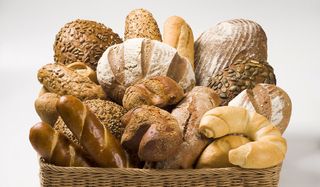Gluten-Free Diet Reduces Risk of Type 1 Diabetes in Mice

Exposure to a gluten-free diet prenatally or very early in life — in the womb or through a mother's milk — may reduce the risk of type 1 diabetes, at least in mice, a new study suggests.
In the study, researchers used a type of mouse that is prone to developing type 1 diabetes. Mouse mothers were fed either a gluten-free diet or a regular diet during pregnancy and the time when they were nursing. When the mouse pups were four weeks old, the researchers transitioned them to a regular diet.
About 50 percent of the mouse pups whose mothers were fed a regular diet developed type 1 diabetes by the time they were 30 weeks old, compared with 22 percent of pups whose mothers were fed a gluten-free diet, the study found.
The researchers, from the University of Copenhagen in Denmark,speculated that the difference in diabetes risk may be related to gut bacteria. The mothers and pups in the gluten-free group had increased levels of certain gut bacteria compared with those on the regular diet.
Gut bacteria are known to play a role in the immune system's development, the researchers said, and type 1 diabetes is an autoimmune disorder in which the immune system attacks the cells of the pancreas that produce insulin. [5 Ways Gut Bacteria Affect Your Health]
However, it's too soon to know whether the findings apply to humans, as intriguing findings in mice don't always translate very well into recommendations for people, said Dr. Victoria Hsiao, an assistant professor of endocrinology and metabolism at the University of Rochester Medical Center, who was not involved in the study. Moreover, the researchers noted that it's not clear if the mice pups in the study that didn't develop type 1 diabetes by the time they were 30 weeks old would end up developing type 1 diabetes later in life; it could just be that the onset of the disease was delayed, the researchers said.
But the findings are interesting and warrant further study in humans, Hsiao said.
Sign up for the Live Science daily newsletter now
Get the world’s most fascinating discoveries delivered straight to your inbox.
In general, there are two groups of people who are recommended to avoid gluten: people with celiac disease, who have an immune-system reaction to gluten,and people who are gluten-sensitive, who feel better after they cut gluten out of their diets, said Cynthia Wu, a clinical dietitian at the Ohio State University Wexner Medical Center. Gluten is a protein found in many grains, including wheat, barley and rye.
People who don't fall into either of these groups would probably not be advised to cut gluten out of their diet in pregnancy, because it is a very difficult diet to follow, Wu said. Gluten-free diets are not known to be risky in pregnancy, as long as women replace gluten-containing foods with healthy substitutes, such as rice-based products and sweet potatoes, Wu said.
Interestingly, celiac disease is much more common in people with type 1 diabetes than in the general population: About 10 percent of people with type 1 diabetes have celiac disease, whereas 1 percent of the general population has celiac disease, according to the American Diabetes Association. The reason for the link is not known, but both conditions are autoimmune diseases an dmay share similar genes as triggers, Wu said.
To follow up on the mouse study, a future study could look at information already collected from women who happened to followed a gluten-free diet in pregnancy, and examine the outcomes in their children, Wu said. Another type of study could follow women forward in time, but this would be more difficult, because it would need to follow children for a long time to determine if they developed type 1 diabetes, Hsiao said.
The study was published April 2 in the journal Diabetes.
Follow Rachael Rettner @RachaelRettner. Follow Live Science @livescience, Facebook & Google+. Original article on Live Science.

Rachael is a Live Science contributor, and was a former channel editor and senior writer for Live Science between 2010 and 2022. She has a master's degree in journalism from New York University's Science, Health and Environmental Reporting Program. She also holds a B.S. in molecular biology and an M.S. in biology from the University of California, San Diego. Her work has appeared in Scienceline, The Washington Post and Scientific American.
Most Popular

